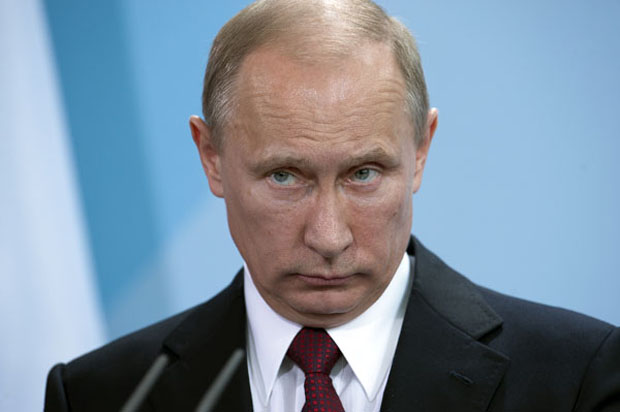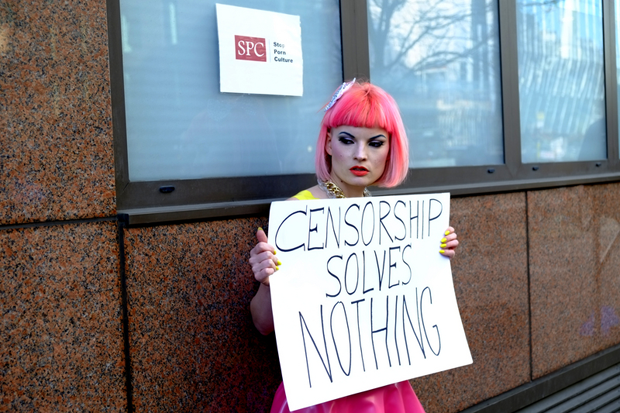14 Apr 2014 | News and features, Russia

(Image: /Demotix)
Censorship of anti-war sentiment in Russia now uses a mixture of state-sponsored media attacks, arms-length loyalists, crooked think tanks and legal strong-arming – but is it working?
Politonline, a website well-known for its support of Putin, has produced an article with the top twenty most “negative” news sources in Russia. Editors claim to have pioneered a methodology which can gauge “emotional sentiment and tone” in online articles. Politonline don’t elaborate on how the algorithm has been put together, or indeed the source data they used. However some of the keywords used have been published, including the words “annexation” and “support for Crimea.”
Meanwhile, a prominent academic has been publically slammed by a pro-Putin think tank, in a pro-Putin newspaper, after he compared Hitler’s strategy in Anschluss with the annexation of Crimea. Professer Andrei Zubov was also dismissed by his employers – the Moscow Institute for International Relations. The Institute for Democracy and Co-operation, the think tank who critiqued the article, included a list of American academics who had lost their jobs over their political views – although many had been fired for comments which were overtly racist, sexist, or incited hate.
The man who blew the whistle on Putin’s invasion in Crimea, Lev Shlosberg, has also been targeted by his opponents. Some of the masked paratroopers now in Crimea were originally based in his home region : Shlosberg helped alert the media when the invasion began. A legislator and newspaper editor, he has since been accused of being a “fifth columnist” and “traitor.” In an interview on the Russia 1 television channel, Putin’s press secretary Dmitri Peskov adopted a similar strategy when he smeared dissenters as “professional critics” and a “nano-fifth column.”
Alexey Navalny, a lawyer, blogger and pro-reform opposition politician has also faced penalties. A lengthy article he published on his blog regarding Crimea prompted authorities to accuse him of breaking the terms of his house arrest. Authorities then blocked access to the site, and warned citizens that anyone promoting his article online would be subject to unspecified sanctions.
Protesters brave enough to go on the streets are also being met with state-sponsored aggression. Tanya Lokshina, Russia Program Director and Senior Researcher at Human Rights Watch, told Index that “anti-war protesters have been subject to arbitrary detention, harassment, intimidation, and even physical attacks.”
Between February 21st and March 4th, the NGO allege that police detained well over a thousand peaceful protesters in Moscow alone. Courts ordered at least fifteen of them to serve ten days of administrative detention for alleged failure to obey police orders, and fined dozens of others for participating in unauthorized public gatherings. The majority are still awaiting administrative court hearings. Other cities have seen similar policing tactics and unfair judicial process.
“Many wondered what a post-Sochi crackdown might look like,” Hugh Williamson, Europe and Central Asia director at Human Rights Watch told Index. “These detentions, the crackdown under way on the media, and violent attacks against dissenters by unidentified assailants paint a stark picture of what is going on in Russia right now.”
So is all this working? In December, Putin’s popularity was at its lowest since 2000, according to a report on the Reuters website. Polling conducted by the Levada Agency showed that “61 percent of respondents voiced approval for Putin’s performance in November, down from 64 percent in October and the previous low this year of 62 percent, recorded in January.”
It’s also notable that before the Crimea crisis escalated, the Russian people were indifferent to Euromaidan. Another Levada poll showed that 63% of Russians didn’t sympathise with either Yanukovych or the protesters.
However a poll by VTsIOM, conducted in March after troops had moved into Crimea, showed that Putin’s approval ratings had leapt up. VtsIOM is state-run but according to Russian politics analyst Mark Adomanis, “remains one of the most widely respected polling outfits in Russia.”
Crimea has sent Putin’s poll numbers skyrocketing,” says Adomanis, who writes a column for Forbes about Russian politics and economics. “Levada currently has him at a little over 80%, his highest level since 2010.”
“Other agencies have shown a similar rebound in his numbers – pretty much everyone agrees that the poll numbers are the best in a long time.”
Adomanis also commented on the lack of media, political and academic freedom surrounding the Ukraine crisis.
“Even in democratic societies there’s always a concern that polling can be heavily influenced by the nature of media coverage. It’s definitely more of a concern in Russia, given the heavy-handedness with which the authorities manage the press
“You can’t totally separate the biased coverage from popular support, but I don’t think one can fully explain the other.”
So Putin’s strategy in Crimea has played out well politically. It’s hard to know what the polls would have been like had the press been able to fully criticise his actions, or had street protests been allowed to go on unhindered. It’s also likely that the long-term economic impact of the annexation will be great enough to push polls down again in the future. However, the tactics used by the authorities to keep dissent out of the public psyche appear well-rehearsed and difficult to counter. A quick review of any Russia Today bulletin, compared with multiple on the ground sources in Kiev, Crimea and eastern Ukraine, reveal that the Russian public are not getting the full picture about their leaders international transgressions.
This article was published on April 14, 2014 at indexoncensorship.org
14 Apr 2014 | Africa, Europe and Central Asia, European Union, Gambia, News and features

Gambian President Yahya Jammeh has bowed to EU pressure to implement political reforms — including changing the country’s restrictions on the media.
This comes barely a year after he rejected a proposal from the European Union to introduce reforms, including repealing draconian media laws, establishing a National Human Rights Commission as proposed by the Commonwealth Secretariat, and abolishing the death penalty within 24 months.
In January last year President Jammeh told local media The Point and Observer newspapers that he will not be blackmailed by the European Union with what he described as “chicken change” to accept what is not in the interest of the Gambia people. He said the “Gambia will never be colonised twice”.
The EU delegation held a closed door meeting with Jammeh last Tuesday to discuss the way forward. Dominique Delacour, the Dakar-based European Union ambassador, told a local journalist that: “We discussed also the issue of consular affairs issuing visas to Gambians. So we had a very frank discussion on an array of issues, which was very productive. The Gambian side also presented their main strategy in terms of governance, and human rights and development cooperation,” she said.
Delacour said the delegation was also in Banjul to present to the Gambian leader with the result of the their preliminary discussions in the country, as well as the declaration that came out of the recent EU-Africa summit held in Brussels.
The European Union is the leading aid provider for the Gambia with a total of €65.4 million of grants allocated for for the period 2008 -2013.
But its demands for more political freedom are seen by the Gambian regime as interference in the country’s domestic politics. Article eight refers to the political dimension of the Cotonou Agreement, the legal framework covering political, developmental and trade relations between the EU and African, Caribbean and Pacific countries, of which the Gambia is a signatory.
A group of Gambian rights activist led by the Amadou Scatted, Janneh former Information Minister who was jailed for attempting to stage a non-violent protest against the dictatorship in Gambia has present a set of recommendation to the human rights bodies ahead of the Universal Periodic Review meeting in Switzerland later this year. This is with a view to pressure authorities to carry out comprehensive reform such as the repealing all draconian media laws, and the protection of human right in general.
However, the Gambia National Assembly on Tuesday unanimously adopted two books entitled A Million Reasons to Leave the Commonwealth and How the Tragic Consequences of British Looting and Misrule in The Gambia Inspired the Foundation of the United Nation’s Drive for Decolonisation in January 1943 and Beyond.
According to pro-government newspaper Daily Observer, the books were authored by the president with a view to reaffirm its commitment to end Gambia’s decade-long membership to the Commonwealth, the 53-member organisation headed by the Queen of England.
Parliamentarian Seedy Njie said in a motion in the first session of the legislative that the content of the books were reason enough for the Gambia to leave the commonwealth. Meanwhile, NJie’s statement has confirmed the argument of Mr Halifa Sallah on the content of the book authored by the authoritarian leader.
This article was posted on 14 April 2014 at indexoncensorship.org
11 Apr 2014 | News and features, Politics and Society, Religion and Culture, United Kingdom, Young Writers / Artists Programme

Protesters gathered outside a Stop Porn Culture conference in March 2014 organised by Gail Dines. Protesters included porn stars, filmmakers, artists, sex workers and supporters who believe in freedom of expression. (Photo: Rachel Megawhat/Demotix)
Last year London Mayor Boris Johnson’s aide, Simon Walsh, was arrested for possession of extreme pornography: depictions of anal fisting and urethral sounding. The respected barrister’ very public prosecution tore his life apart and lost him his jobs. In just 90 minutes the jury threw out his case – Walsh’s images were safe and legally produced.
The law under which he was prosecuted (Criminal Justice and Immigration Act 2008) was intended to affect only 30 people per year, but over 1,300 were prosecuted in 2012/13 alone. Clarification of what should be classed as “extreme”, promised by the Lords, never materialised. Government lawyers have attacked a wide range of materials, many of which juries consider innocent.
Now the government is sneaking through a vast extension to pornographic prohibition. It’s so vaguely worded that it could cover 50 Shades of Grey (if filmed), Game of Thrones or Florentine statues. Those found guilty of possession could face 3 years in prison and an unlimited fine.
Under the cloud of Cameron’s anti-child abuse crusade, possessing explicit/realistic portrayals of “the non-consensual penetration of a person’s vagina, anus or mouth by another,” real or simulated, will be illegal. The rhetoric that launched Claire Perry’s disastrous internet filtering initiative – the one that blocks abuse support, sex education and suicide helpline websites – also mandated this law. That rhetoric displays utterly muddled thinking, a confusion between stopping child abuse, stopping children accessing adult material and stopping anyone accessing non-mainstream material.
The change’s motivation is laudable. Genuine rape or abuse depictions (i.e. filming real crimes) should be illegal, all agree. Some women’s groups argue exposure to violent pornography affects viewers’ behaviour- RASASC calls the move a “step forward in preventing rapists using rape pornography to legitimise and strategise their crime”.
However, campaigners contend the draft law’s language is too ambiguous. A policy researcher from anti-censorship organisation Backlash argues: “The law will cover much more than the legislators imagine or intend.” Passing this law as an appendage in a “bumper bill (that includes) lots of legitimate concerns – a radical overhaul of probation and legal aid – (means this) very delicate matter isn’t getting appropriate democratic oversight”.
The government’s strategy, using child pornography as a blanket justification, makes effective opposition or refinement impossible. No politician spoke against the amendment in the bill’s readings or committee stage. Which MP, mindful of re-election, would stand for the right to possess violent erotica? Labour support the provision uncritically, denying it appropriate scrutiny.
Such a serious proscription, which might endanger harmless women and men, merits its own public debate, not back-door legislation. Solicitor Myles ‘ObscenityLawyer’ Jackman, who represented Walsh, highlights the dangerous subjectivity of judging pornography “realistic”, plus the “absence of any evidence proving…a causal link” between such material and Cameron’s “normalise(d) sexual violence against women”. A representative survey of 19,000 UK adults cited by three academics shows 1/3 of adult fantasies include domination or submission, and about 5% of Britons fantasise about delivering/experiencing violence. These academics’ parliamentary evidence repeated Jackman’s scepticism of the link between pornography and real-world crime. Groups like Rape Crisis South London and the End Violence Against Women Coalition assert such pornography does promote dangerous beliefs. The government itself “believes such images are unacceptable and most people would regard them as disgusting and deeply disturbing,” implying the majority’s moral distaste is grounds for legislation.
Groups like Sex & Censorship and Backlash protest the bill’s wording and justification, arguing millions of law-abiding kink practitioners might be criminalised for depicting safe, consensual, private acts. Sexual minorities including the LGBT community, bondage enthusiasts, horror-movie recreators and “vampire and goth enthusiasts who use fake blood in roleplay” could be covered, Backlash told me. Even Rackley and McGlynn, the Durham University academics who championed this law for years, criticise the bill’s wording, demanding clarification specifically banning “realistic images”, protection for “private depictions of consensual BDSM activity” and consideration of context.
Sex-positive feminism raises questions over what the bill would achieve. Arguments that violent pornography (and general sexual imagery) warps childhood development, perpetuates objectification and enables rape culture are valid, but attacking one subsection of pornography won’t stop children seeing questionable images. They fill celebrity magazines, tabloids, advertising and primetime TV.
In terms of child protection, then, this may be window-dressing. It’s far more important for schools to promote effective sex education covering consent, gender, identity and relationships, rather than a “see no evil” approach. Such education is woefully lacking and outdated. Meanwhile the government has cut funding for sexual health services for vulnerable teens and youth services, and is attacking endangered women’s panic rooms via the “bedroom tax”.
The government may be simultaneously attacking the harmless, and harming those who are helpless. The extension of extreme pornography censorship is dangerous because it’s had minimal public discussion, the wording is poorly considered, and it’s unlikely to address the problem used to promote it.
This article was published on April 11, 2014 at indexoncensorship.org
11 Apr 2014 | Digital Freedom, India, News and features, Politics and Society

(Image: Sergey Nivens/Shutterstock)
Established in 2009 by executive order, the Unique Identification Number Authority of India (UIDAI) has taken on the monumental challenge of issuing each resident of the country with a Unique Identification Number (UID), more commonly known as the Aadhaar card. The driving idea behind the card was to ensure that residents could have a singular identification card that can eliminate duplicate and fake identities and also can be verified in a cost effective manner. Biometrics are the primary method for identification, while other details such as addresses, family, and even bank accounts are linked to the card.
Recently, the UIDAI was in the news as it challenged an order by the Goa High Court to share biometric details of all enrolled Goa residents with India’s Central Bureau of Investigation in order to solve an investigation. The Supreme Court of India ruled that UIDAI did not need to share its data with any agency of the government without the consent of those in its database. In his blog, the former Chairman of UIDAI (and currently running for a seat in India’s hotly contested national elections) Nandan Nilekani wrote: “We have always stated that the data collected from residents would remain private, and not be shared with other agencies.”
An audible sigh of relief was heard in the media from privacy activists who were concerned that the data collected by the UIDAI would be easily accessed by any government agency once it was in the system. This concern for privacy and data protection isn’t completely unfounded. Indian media has reported on grave gaps in the data collection process. In March 2013, a Mumbai paper reported that data collected from residents in 2011 was still lying around in cupboards in a suburb, despite the area residents repeatedly reminding the authorities to take away the information. The same state had, in 2013, “admitted the loss of personal data of about 3 lakh [100,000] applicants for Aadhaar card”, an error that sparked concerns over possible misuse of the data, not to mention the trouble of having to register personal data all over again. According to the report, the data had been lost while uploading from the state information technology department to the UIDAI central server in Bangalore, Karnataka. Government officials tried to assure the public that the data was highly encrypted and could not be misused. However, this incident wasn’t unprecedented. Just the year before, veteran journalist P. Sainath of the Hindu had highlighted this issue in a talk, saying that: “You can buy that data on the streets of Mumbai. It’s already made its way there. What sort of national security will you have when your biometric data is up for grabs all around the planet? You outsourced it to subcontractors who have subcontracted it to further people. It’s now available on the streets of Mumbai, biometric data.”
Given that the government has spent Rs 3800 crore (around $600 million) on the project already, it is interesting to note that India has not yet passed a privacy law, a comprehensive data protection law and nor did the parliament pass the National Identification Authority of India Bill, which was rejected by a parliamentary standing committee on finance in 2011. As was reported at the time, the standing committee rejected the report on the grounds that the scheme had “no clarity of purpose and leaving many things to be sorted out during the course of its implementation; and is being implemented in a directionless way with a lot of confusion”. It also went on to raise concerns about privacy, identity theft, misuse, security of data and duplication during the implementation of the UID scheme, and cited global examples of similar schemes that were rejected.
However, it is useful to see the guiding principles behind the implementation of the scheme that made it so attractive to the Congress-led UPA II government. The spirit of UID seems to lie in two guiding principles; using Public-Private Partnerships (PPPs) to make government more effective, and entering the data game. In a recent interview to the Economic Times, Shrikant Nadhamuni, who headed technology for UIDAI is quoted as saying: “We wanted to move the ID game—from a state where some people had no ID and others had paper ID to something beyond even what Singapore had, in the form of smart cards, to online. Like biometric. Which is the future.”
The basis of the design of what was to become the UID was also laid out in the Report of the Technology Advisory Group for Unique Projects, submitted to the Ministry of Finance in 2011, headed by Nandan Nilekani, a respected figure in Indian business and later to become CEO of UIDAI. Others involved with the report were the chairman of the Security and Exchange Bureau of India (SEBI), the secretary, Department of Telecommunications of the Government of India, the chairman of the privately owned IFMR trust which seeks to ensure that every individual and enterprise has access to financial services, and a few other experts on the subject. Many government officers constituted the secretariat. The report put out some revolutionary ideas about how to integrate private expertise into the public sector. It deduces that “the most important lesson that needs to be acted upon is that business change’ should drive the design and implementation of these projects”.
This was to be done by implementing a National Information Utility (NIU), which would be private companies with a public purpose: profit-making, not-profit maximising. The NIU would be flexible in its functioning, and the government would keep strategic control over the project. Private ownership of the project should be at least 51% and the government’s share at least 26%. Once the NIU is to become steady, the government would become a paying customer and would be free to take its business elsewhere. However, the report also admits that given the massive investments in building the NIUs, they would essentially be set up to be natural monopolies. At the time, the report had looked at the following schemes of the Indian government: Goods and Services Tax (GST), Tax Information Network (TIN), Expenditure Information Network (EIN), National Treasury Management Agency (NTMA) and New Pension System (NPS). The first Unique Project to take off, however, was the UIDAI.
This strategy raised red flags as well. Usha Ramanathan, an academic activist, wrote in Moneylife that: “In this set-up, we are witnessing the emergence of an information infrastructure, which the government helps — by financing and facilitating the ‘start-up’, and by the use of coercion to get people on to the database — which it will then hand over to corporate interests when it reaches a ‘steady state’.” She continues in the same piece that: “The NIU was not explained to parliament, and no one seems to have raised any questions about what it is. This, then, is the story of how the ownership of governmental data by private entities is silently slipping into the system.”
Controversies surround the Aadhar project. Nilekani, who was appointed Chairperson of UIDAI in 2009 by the current UPA government, and simultaneously given the rank of a cabinet minister, is increasingly in the news because rumours are swirling in India that a new government might choose to shelve the project. The card, that was envisioned to become an almost one-stop-shop in the future years regarding the delivery of welfare schemes and subsidies, is no longer mandatory to avail some of these, according to India’s Supreme Court. This is a setback to the government that considered the Aadhar card a method to plug “leaks” in the government delivery systems. Despite this, reports of data leakage, and even stories of fake Aadhar cards making their way into the news, the current establishment seems hopeful. The deputy chairman of India’s Planning Commission, Montek Ahluwalia, made a statement that the card did not require a legal basis to be used for transferring benefits to citizens, much in the same way citizens are not legally required to hold degrees to gain jobs.
The UIDAI project remains complex – a herculean task. The UK government shelved its identity card project because it was untested and the technology not secure, and because of the risks to the safety and security of citizens. With India in the midst of an election, it remains to be seen what will happen when a new government is formed, and whether the country can succeed in this task.
This article was published on April 10, 2014 at indexoncensorship.org




